Supreme Court Remains Silent In Case Involving Students Wearing American Flag Shirts
The Supreme Court declined to hear the appeal of three students disciplined for wearing American flag shirts on Cinco de Mayo
Yesterday, the Supreme Court refused to hear the appeal of a group of California High School students who had been forbidden from wearing American flag t-shirts on Cnico de Mayo, a case that sparked a nationwide debate over the the issue of student free speech rights versus the extent to which school authorities have the power to regulate behavior under the banner of maintaining discipline:
WASHINGTON — The U.S. Supreme Court on Monday left intact an appeals court ruling that school officials in California did not violate the free speech rights of students by demanding they remove T-shirts bearing images of the U.S. flag at an event celebrating the Mexican holiday of Cinco de Mayo.
The court declined to hear an appeal filed by three students at Live Oak High School in the town of Morgan Hill, south of San Francisco. School staff at the May 5, 2010, event told several students their clothing could cause an incident. Two chose to leave for home after refusing to turn their shirts inside out.
The school had been experiencing gang-related tensions and racially charged altercations between white and Hispanic students at the time. School officials said they feared the imposition of American patriotic imagery by some students at an event where other students were celebrating their pride in their Mexican heritage would incite fights between the two groups.
Lawyers for the students said that the fear that the T-shirts would offend others did not trump free speech rights because the act of wearing the shirts did not rise to the level of incitement to violence.
(…)
In the February 2014 ruling, the San Francisco-based 9th U.S. Circuit Court of Appeals said officials did not violate the U.S. Constitution’s First Amendment, which guarantees freedom of speech. School officials acted out of legitimate concerns of violence when they sent a handful of students home for refusing to change their American flag-embellished apparel, the court said.
Several legal observers, including a group led by UCLA Law Professor Eugene Volokh raised concerns about the Ninth Circuit’s ruling in this case because of the extent to which it seemed to give the so-called “heckler’s veto” a role in deciding how far administrators could go in limiting the free speech rights of students. While it was apparently the case that there had been incidents of violence and racial tension in the school in the months leading up to the incident in question, the Court’s ruling appeared to be saying that this gave school authorities the right to limit student speech because of how other people might react to it. For obvious reasons, the case itself became prominent because of the fact that school authorities were banning students from wearing a shirt depicting the American flag on a “Mexican” holiday, albeit one that is more popular in the United States than it is in Mexico, meant that the case soon became part of a larger political controversy. This was especially true on the right, where it often got folded into the larger debate over immigration and the integration of newer immigrants into American society and culture.
On some level, this outcome isn’t entirely surprising given the direction that the Supreme Court has been taking on the issue of student First Amendment rights in recent decades. In the mid-20th Century, of course, the Court had ruled that students could not be forced to recite the Pledge of Allegiance in the landmark case West Virginia State Board of Education v. Barnette. Two decades later, the Court ruled in Tinker v. Des Moines Independent Community School District that school districts could not discipline students who had taken part in a protest against the Vietnam War on school grounds during school hours. In the years since Tinker, though, the Court has issued rulings that have seemed to reinforce the authority of school authorities to regulate student speech in the name of school discipline. In Bethel School District v. Fraser, for example, the Court upheld a school’s decision to discipline a student who had given a speech laced with sexual inneundo during a student assembly, even though the speech itself was not necessarily obscene. In Hazelwood v. Kuhlmeier, the Court sided with school authorities over students in a case involving regulation of the content of a student newspaper. Most recently, in Morse v. Frederick, the Court had ruled in favor of school authorities who had disciplined a student over speech that took place outside of school ground despite the fact that there was no evidence that the speech had disrupted the school in any way. Since then, the Court has largely dodged cases dealing with issues involving First Amendment rights in the context of public education, including just last year when the Court declined to hear the appeal of a school district that had attempted to discipline a group of students who had been handing out bracelets with the message ”I ♥ boobies,” as part of a breast cancer awareness campaign. And now, of course, the denial of this appeal is added to this list.
As I’ve said before, we can’t be sure why the Court denies an appeal in a particular case beyond the very simple fact that there were not four Justices who voted to hear the case. Why that happened to be attributable to anything from the fact that there is some kind of procedural or factual flaw with the case that they believes makes it inappropriate for Supreme Court review to the possibility that the Justices do no believe it is necessary for the Court to speak any further on this issue at this time. It’s unfortunate the Justices did not accept the case, though, because it raises important issues that students and school administrators have to deal with on almost a daily basis. Admittedly, school administrators do need to have some authority to regulate behavior in order to ensure that the school is able to achieve its prior mission of education. The question is how far they are allowed to go in exercising that authority and, in this case, it seems clear that the school administrators in California went a step too far. Even if it were true that wearing the American flag on this particular day may have provoked a response from some other portion of the student body, that alone should not be a basis for squelching activity that is clearly protected by the First Amendment. Because if that’s the criteria, then we are indeed giving the heckler’s a veto over speech, and that’s a road that we really ought not travel down.
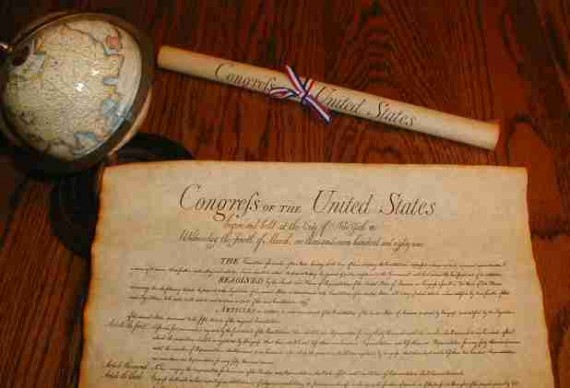

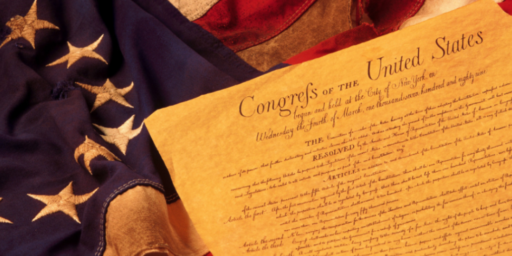
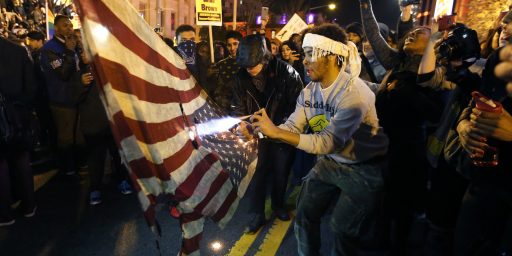
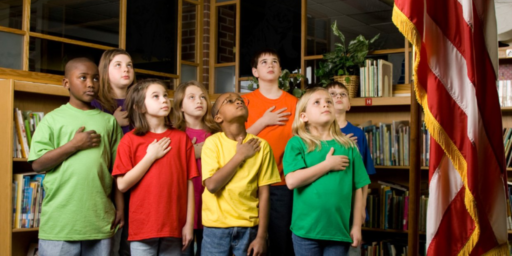
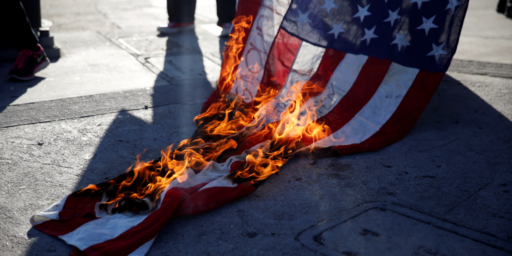
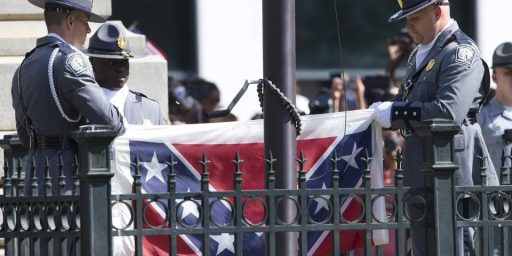
Let’s hope the students wear t-shirts with upside down US flags next year.
Evidence that, at least in an educational setting, the minority has the right, through fear and threats, to deny anyone the ability to speak. What messages/images on shirts will be banned next? Christ has risen? I support the 2nd Amendment? Che Guevara? Dr. Martin Luther King? Malcom X? Police brutality is UNLawful? John 3:16?
A handful of students that don’t like said images/messages can simply express their dislike and suggest violence to the wearers and that message/image will then be banned.
Yeah, that’s the message we want to send.
Doing or saying something that could hypothetically make someone angry is not “inciting violence.” If someone reacts violently to seeing an American flag on a t-shirt, the school should deal with that individual.
Is there a coherent set of generally recognized rights for high school kids, or are their rights contingent on each school’s administration discredition? In my day, hair length for guys and skirt length for the gals were battle grounds. My daughter teaches in a school now and risked her job by quietly confiscating a table knife that a student had brought with his lunch; she did not notify her superiors that the no weapon policy had been breached and gave the knife back to the kid at the end of the day. I guess what I’m asking is whether high school students have the same rights inside the school as I do walking down the street. BTW, what if an employer banned certain T-shirts, would you all consider this improper?
No wonder many parents and administrators think that schools should have uniforms.
Cinco de Mayo? American Flag? Whatever.
What’s interesting is that the same parents who have their kids wear an American Flag t-shirt are probably the same parents who worry incessantly about desecration of the American Flag.
@Slugger:
No. Private employment is different than government schools. Private employers can restrict speech and not violate the 1st amendment while government cannot. Schools are a different category. The courts have said, and I’m paraphrasing, students have a “reduced” 1st amendment right if that speech causes a disturbance.
@al-Ameda: You do realize a print of the American flag on a shirt is not actual desecration of a flag, right? Right?
@Jack:
What’s your stance on American flag underwear? Or American flag swim trunks? Or American flag bathing suits?
@PJ: I could care less.
Probably has no meaning to 99% plus of the US but there actually is a federal standard for display of the flag. My crazy neighbor who flies the stars and stripes 24/7 just above the Gadsden flag is in violation. It’s actually supposed to be raised ‘briskly’ each morning and lowered ‘ceremoniously’ every evening and not displayed in inclement weather unless it’s an ‘all-weather’ flag (according to the wikipedia entry). This is an ‘advisory’ law because the Supreme Court (correctly IMO) has ruled that display of the flag is a first amendment issue.
But in case anyone is actually interested, it is technically a violation to wear the flag as clothing.
I know, I know, I know — nobody but hopeless old fuddy-duddies like me gives a rat’s … about that. Using it as a gang color does seem pretty poor citizenship to me, however. That’s what the school system forbade, the 9th Circuit forbade and the Supreme Court apparently also forbade. Now if my neighbor could be charged or at least given some sort of citation that makes him haul his butt to court to defend his 1st Amendment use of the flag.
While looking the flag statute up, was reminded of the 1908 event in which the American team at the London Olympics refused to dip the flag to King Edward. The shot putter Ralph Rose is supposed to have said, ‘this flag dips for no earthly king’. Which began an Olympic tradition that continues to this day.
Sometimes I have to wonder at myself — a pretty far-left liberal and peacenik inclined old guy who gets ridiculously huffy about proper vs improper display of the flag. But, as Tyrell no doubt remembers Walter Cronkite saying, “that’s the way it is.”
@JohnMcC: There is a difference between using an actual flag as a piece of clothing, and printing stars and stripes on material to make it look flag-like and then using said material in clothing.
Larry Flint wore an actual flag as a diaper–still 1st amendment protected but technically violates the laws governing the use and display of a flag.
US Swim Team using material printed with flags as swimwear–does not violate the laws governing the use and display of the flag.
“The flag should never be used as wearing apparel, bedding, or drapery. It should never be festooned, drawn back, nor up, in folds, but always allowed to fall free.”
https://www.senate.gov/reference/resources/pdf/RL30243.pdf
@Jack:
You do realize that it’s not the actual cloth that’s important but what it symbolizes, right? Right?
On it’s own, it is cloth dyed 3 shades with some shapes on it. Pretty colors and basic bars and stars taped to plastic or wood. Cheap and meaningless. Together, it represents our history, our ideals, and our freedom. It’s power comes from it’s meaning – the total assembly grants it context somebody just wearing red, white and blue together doesn’t have.
I have never understood the flimsy logic of why it’s “respectful” to treat one configuration (flag as THE flag) one way and not any other. You wearing something flag-shaped or deliberately colored specifically because it symbolizes America’s flag, because you want that deeper meaning? You damn well better treat it like a “real” flag because it essentially *IS* one. Otherwise, you’re cheapening it and yourself in a vain attempt to appear “patriotic” and have a visible symbol of how much you “love ‘Murica”.
@KM: Tearing up a picture of a bald Eagle–legal.
Killing a bald Eagle–illegal.
The clothing issue is, it’s not an ACTUAL flag. If you cannot understand the difference, then you need help.
Regardless, expecting people to pay respect/reverence/worship a symbol is also illegal. Just because Muslim revere the Koran, does not mean I have to.
@Jack:
When you salute a flag, you’re not saluting the fabric but the nation it represents – just like a Christian isn’t praying to a Cross but the God it symbolizes. It’s a tangible thing for an intangible idea. If you cannot understand that kind of abstract thinking, find an adult to explain it to you in small words. And if you can’t understand the difference between killing a living thing and a pic of one, the nice men in the panda car will be outside shortly.
You are making a distinction where there is none because you want to be able to wear little flag pins. I find it vastly interesting that this is a relatively new phenomena; most generations prior to the Boomers understood that flags shouldn’t be clothes. Wonder what changed?
@KM: @Jack: from Flag Etiquette on the WIKI page Flag of the United States.
“Representing” the flag on a tee shirt would seem to violate flag etiquette.
@Jack:
Why yes, so it is. Nobody’s said otherwise; we’re just pointing out the hypocrisy of conservatives “loving” the flag so damn much they disrespect it every chance they get while the party that traditionally burned the thing has to school you guys in its care.
Nobody’s saying make flag clothes illegal but I do think it’s fascinating that’s immediately where your mind went. We point out you’re doing it wrong in the classical sense; you start talking about whether things are banned/illegal or not. Projection, much?
@gVOR08:
No. It does not. Congressmen and Presidents wear flag lapel pins. The text plainly reads the flag should not be used as wearing apparel or used as a costume or athletic uniform.
No one would confuse apparel printed to look like a flag with an actual flag. The only way to violate this etiquette is to take an actual flag and turn it into clothing.
Oh, each of these cases actually have strategic value. At some point, probably soon, the Left is going to try to force homeschoolers into the public indoctrination centers. Now the laws only say that public education will be provided. They also say kids must be afforded an education. You could argue the state can set the standards, but not the means of that education. So when they go after homeschooling, the argument can be made that to attend a public school a student is forced by these cases to surrender some portion of their Constitutional rights. However, homeschooling is a way to meet the requirement that kids be educated, so as to be of use to the State, in the least intrusive manner compared to public schooling.
@KM: We point out you’re doing it wrong in the classical sense; you start talking about whether things are banned/illegal or not. Projection, much?
conservatives “loving” the flag so damn much they disrespect it every chance they get while the party that traditionally burned the thing has to school you guys in its care
@Jack:
So what is the qualitative difference then? What is the correct and definitive criteria to make a flag an “actual” flag? From the above, you just ruled out silk-screening or printed flags like you can buy here.
Are these “actual” flags? Must they be hand-sown and dyed to qualify?
@KM:
You seem to equate disparaging a symbol equates to disparaging the thing it actually represents.
If a religion or nation is so weak that it cannot suffer a little misuse or even condemnation to its symbol then there are bigger problems than people burning flags/korans/crosses/images of Jesus or wearing those symbols as articles of clothing.
@Jack: I would be interested in some definitive difference between something that accurately ‘represents’ the flag and the flag itself.
A true story that happened in ’69 in Jackson TN: Couple of friends of mine were in a drunk and stoned condition at college. A nearby cemetery had a locally famous monument dedicated “to the American dead in World Wars 1, 2 and 3” which was kind of fun to go look at when sufficient intoxicants were involved, so that’s what they did. On their way back to campus they picked up (I s’pose you could say they ‘stole’) a little paper American Flag that lined the path to this monument. They were waving it about (singing the Colonel Bogie March) when they came into the Student Union building for some munchies. Someone was lighting a cigarette and the little dessicated paper flag was waved through the flame and burst into flames just in time for the school’s security guard to walk into the room. Turns out his son was in VietNam and he took it pretty hard and reported this to the local police. The goofy character who was holding the “flag” as it burned was convicted of a federal crime (which is no longer a crime because of the 1st Amendment).
My question: Was the little paper thing a “real” flag or a “representation” of the flag?
I’ve always though it was a real flag. The police and a federal court thought it was a “real” flag. I’ve always thought Mr Flint’s diaper was a “real” flag.
I was offended at the use of the flag in all these cases but didn’t think any law should exist to forbid such a use or penalize the person who’s “speech” desecrated it because…1st Amendment. I don’t have the right to go through life un-offended.
But given the question ‘was it actually a flag’ my answer would be ‘of course’. Please remember that it was the so-called-conservatives who lectured us for years that ‘words have meaning.’
@Slugger:
At least here in California there is a lot of settled law and in addition to that, school policy.
I know because about a year ago I was picking my son up at his High School. As I drove up I noticed he was in a tense exchange with the man who manages the school’s physical property. Turns out the guy had objected to Jake dropping multiple F-Bombs. Jake had of course memorized state and federal law plus school policy and by the time he was done the adult literally apologized and Jake went on being obnoxious.
@KM:
Anything that is intended to be a flag, for as in a display as a flag, qualifies as a flag.
Underwear with a flag printed on it was not intended to be flown, posted, used, raised, represent, or any other verb you want to use, as a flag.
@JohnMcC:
It was intended to be a flag, and in a display as a flag, it qualifies as a flag. It matters not what it was made out of.
@JohnMcC:
There’s also a very specific definition of what qualifies as a flag, and most flags aren’t flags in the legal sense (in most cases, the flags you buy at the store aren’t in the proper aspect ratio to qualify as an official flag).
@JKB: I have a completely different sense of the direction in which the zeitgeist is flowing. It seems to me that greater and greater support for individualism and personal choice is being given while uniformity and homogeneity get less and less respect in the culture at large. The pendulum seems to have swung pretty far past “respect for individual choice” to the level of “atomizing the population” I think. But that’s just me. Hell, I’m old enough to remember my draft notice and the whole country thought that was a perfectly normal thing.
It probably would be hard to find any sort of definitive scale to measure this of course. But I doubt that you are likely to be forced into public schools in the future. When I was a younger fellow, you very well might have been.
Would definitely have improved your mind.
@JohnMcC:
I lethargically raise my flag every morning and I usually half-ass the lowering in the evening.
But that’s okay – in fact, it’s expected; I’m center-left, so, therefore, I hate America. 😉
@Jack:
Actual flags are ensouled at the factory in Bangladesh where they’re traditionally made. Just before they’re shipped, a guy holding a plate of hotdogs and a slice of apple pie touches each pallet of proto-flags in a sort of Blutfahne ceremony.
@Stormy Dragon: Well dern, that’s pretty interesting. Is there a certifying organization or a mark applied to ‘real’ flags?
@Jack: Similarly, is there any way for someone to show that they ‘intend’ this item to be a ‘real’ flag whereas this other thing is a ‘representation’ of one? Or is it kind of like the Episcopalian eucharist that is ‘real’ if you choose to believe in it but only a piece of bread if you don’t.
From above:
Section 3 of the Flag Code[75] defines “the flag” as anything “by which the average person seeing the same without deliberation may believe the same to represent the flag of the United States of America”.
It strikes me that if you asked someone what was represented on the T-shirt – they’d say “a flag”.
@JohnMcC:
Well, now you’re just making to much sense. To suggest that a person must form intent is just CRAZY in this day when everyone has a right to not be offended.
@pylon:
The correct question would be, “What is depicted on the T-shirt”. There is no doubt in my mind that a picture on a T-shirt does not in fact “represent the flag of the United States of America”.
I wonder if the school raised the US flag on their pole that day, and what about the flags that are displayed in the classrooms ? Did these misguided school officials ban those too ? Any of the students or school officials who have a problem with the US flag have a choice: move to Mexico. I assume if the students had refused to remove the shirts they would have been suspended and arrested. For some reason, many school officials have either been out in the playground sun too long or have hit their heads on the monkey bars too many times.
Here are some other famous crazy school suspensions: student suspended for having “marijuana” leaves – turns out to be Japanese maple ! Student suspended for gun shaped pop tart ! Student’s bubble blower gun gets him suspended ! Student in Florida disarms gunman, saves students’ lives – thanks from the school system is a suspension ! 6 year old held by police for hours after bringing toy cap pistol on school bus ! Student’s history project earns her – a suspension ! Seems like she drew some Civil War rifle diagrams. But she got an A on the project from her intelligent history teacher !!
It is just so bizarre and crazy the way things are going. The loss of freedoms continual to increase.
I can’t think of any time we’ve needed this more:
https://youtu.be/LeyofQK6tRw
@JohnMcC:
It is a quantum flag. Simultaneously both flag and non-flag. The only way to determine its state is to run it up a flagpole to see if anyone salutes.
Since we have (not) solved the issue of what is a flag, I would like to return to the rights of high school students. In my day, there was alot of consternation about hair length, but if you combed your hair back into a DA style they left you alone while Beatle style got you expelled. On the other hand, you could carry a clasp knife but not a spring loaded knife with impunity. Now, kids can have long hair in a variety of colors, but woe will fall on carriers of a plastic picnic knife. In high school I found the rules arbitrary, capricious, and stupid; a good preparation for real life. Are the rights of high school students universals, or are they mostly dependent on the zeitgeist?
All of this talk of representations of “real” things reminds me Magritte’s “The Treachery of Images.” (That painting of a pipe that also carries the caption “Ceci n’est pas une pipe” or “This is not a pipe.”)
@de stijl: Our conservative friend has become Schrodinger but with a flag instead of a cat. What fun!
@Jack: “There is a difference between using an actual flag as a piece of clothing, and printing stars and stripes on material to make it look flag-like and then using said material in clothing.”
What do you suppose an “actual flag” is – some kind of holy relic touched by the Founders? There isn’t a certificate of authenticity for a flag — anyone can make one, and I can’t see how it makes a difference whether it’s printed or woven.
@Jack:
Correct.
Irrelevant here.
Correct again.
The key feature here that everyone except Slugger (and michael in reply) has missed is that we are not talking about adults in generic situations. We are talking about children, in schools.
The phrase “student free speech rights” is an oxymoron of the worst kind. Students in school do not have the freedom to speak whenever they like, much less whatever they like. You could not have a functioning school if they did. I have no idea why anyone thinks this is controversial, or a Bad Thing.
The flag is a red (and white and blue) herring here — the issue would be exactly the same if we were talking about wearing orange on St. Patrick’s Day, or gang colors in general.
If you want to worry about real first amendment rights issues, go back and look at
which is a much scarier thing that refusal to hear the current case.
@KM:
God hates flags.
Discussions of the Theory of Flagdom aside, I don’t see how the Court could have reached any other decision. They’ve ruled that a student can be punished for wearing a T-shirt reading Bong Hits4Jesus. If they now turned around and said that schols don’t have control over students wearing a flag with a different meaning, then they are saying that some speech content is protected while others aren’t…
@Slugger:
Based on the proliferation of “stupid school” stories lately, I’m going to go with Administration Does What It Wants Till the Courts Step In for 500, Alex. Since most schools (and parents) want max local control, the standardizing of student rights into something cohesive and codified at even a state level would be….. problematic at best. Some of the best political debates I’ve ever witnessed were at school board meetings; child-as-property parents vs special-snowflake everyone-gets-an-A soccer moms was my all time favorite.
@Jack:
You do realize that if that kid who wore a print of the American flag on his shirt, decided to wear it during a paint ball fight, that many parents would think that paint splatters on the shirt’s print of the American flag would be a desecration.
@Jack:
Jack –
You’re wrong, and it’s not surprising.
If I take a flag t-shirt, and put it on a pole, and raise it up in front of my house, it’s an effin’ flag. It is.
A flag is a SYMBOL of something: Country, State, Club, Group, etc. What it’s made of is irrelevant.
For anyone interested, the current specification for an official US flag is spelled out in:
Executive Order 10834 – The Flag of the United States
@EddieInCA:
Wrong. It’s still a shirt. It was designed as a shirt with a print of the flag as decoration and did not magically become a flag simply because you raised it up a flag pole.
@Jack:
A symbol is either a symbol or it isn’t.
If we want to say a shirt with the image of the flag isn’t a flag, then banning the shirt shouldn’t be an issue.
The reason its an issue is precisely because the image on the shirt WAS a symbol.
@Liberal With Attitude:
The school district didn’t want any US symbolism displayed by school children on Cinco de Mayo because they thought children of Mexican heritage would be upset. This hypothetically could have extended to flag stickers on book sleeves, red/white/blue face painting, flag hair clips, etc. The schools simply did not want any USA rah, rah on the 5th of May because someone might get violent.
Because, you know, people cannot responsibly be proud of their heritage without beating up on those who hold differing opinions.
@Jack: As I said earlier, I wonder if the school even put the flag up that morning (US flag, that is). The very idea that a person can’t wear or display the US flag without worrying about someone getting offended or upset is absurd. The school officials got it backwards. They should have told the students if the US flag bothers them, they are free to go to Mexico. Or Russia.
“These colors don’t run” (Charlie Daniels)
“I thank my lucky stars
To be living here today
‘Cause the flag still stands for freedom
And they can’t take that away!” (“God Bless the USA”, Lee Greenwood)
@Tyrell:
Depends on your wash cycle. And if it’s a cheap shirt made in China, forget about it – it’ll fade to pink, off-white and sky shortly.
@Stormy Dragon: I really don’t know why I’m carrying on this rather silly conversation and carrying it so far. The important thing is that school administrators have the authority to ban displays of the flag if there is the likelihood that it is being used as, essentially, gang colors and that this has so far passed muster in the courts. Got it. Also there’s a completely unsurprising subtext that the Feds get to decide what the flag actually looks like — in detail and with authority. OK. Got all that. Important questions all noted.
But that citation of Executive Order 10834, did you notice that it doesn’t specify whether there are 7 red stripes and 6 white ones or the reverse? Or that the stars are the 5-pointed Betsy Ross stars or 6-pointed stars of David or 4-pointed stars of Bethlehem?
Apparently there can be lots of variations that fall within the confines of that order. I bet — repeating that this is just an amusing little jaunt into the woods not a meaningful debate — that there is somewhere in the Federal laws and rules and such a much more detailed description of the flag. I seem to remember — God! from a Boy Scout Handbook, maybe — that the ‘union’ (the blue rectangle with the stars) — has a certain proportion compared to the total dimensions of the flag.
But who polices the manufacture and distribution of flags to make sure they’re ‘correct’? Who certifies them? For flags bought by the gov’t for military posts and ceremonial occasions, I bet there probably is such a certification. But I bet that’s a very small percentage of the flags bought and sold.
Not trying to argue since I don’t really have a point to make except that like pornography, we recognize it when we see it even if the definition is elusive.
There are three important considerations in this unfortunate, shameless case. The school oficials erred grievously in denying students in an American school the right to wear an image of the US flag. These officials should have to apologize publicly to the students, their families, the student body, the taxpayers of that district, and to the military service people and all veterans/families. Veterans who have served this country honorably and in some cases given their lives so that the people of this country can have freedom, which includes the right to display the US flag, irregardless of what some government bureaucrat or Supreme Court judge thinks. There needs to be a law that protects the right of all Americans to display the flag, including in schools. I guess next they will have pictures of George Washington and copies of the Declaration removed. Some schools have already stopped doing the Pledge to Allegiance !!
@Tyrell:
As you know, the Pledge did not become a common feature until World War II, and in the 1950s when the Cold War was full on, we added “under God” to the Pledge.
All of this begs the question: Just how did this nation survive nearly 160 years without the Pledge?